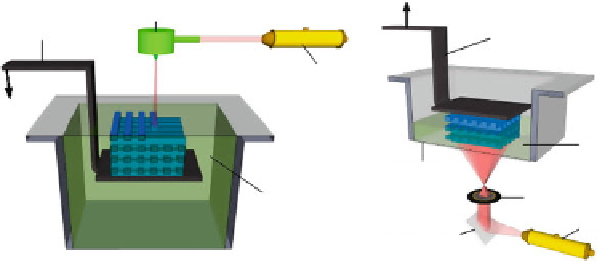Biomedical Engineering Reference
In-Depth Information
Scanner system
(XY-movement)
V
2
Fabrication platform
Fabrication platform
Laser
V
2
Liquid photocurable
resin
Coated glass slide
Lens
Liquid photocurable
resin
Laser
Digital Mirror Device
(DMD)
BOTTOM-UP
TOP-DOWN
Fig. 9.3
Scheme of bottom-up (
left
) and top-down (
right
) stereolithography set-ups. The bottom-
up set-up shown, is an example of a system whereby the laser scans the surface for the curing of
the photosensitive material. In the example of the top-down set-up, dynamic light projection tech-
nology is used to cure a complete 2D layer at once
(commonly UV light), a system that controls the xy-movement of the light beam and
a fabrication platform that permits movement in the vertical plane. Scanning the sur-
face of the photosensitive material produces 2D patterns of polymerized material
through single photon absorption at the surface of the liquid material. The build-up of
a 3D construct is made possible using a layer-by-layer approach, whereby the fabrica-
tion platform moves stepwise in the
z
-direction after a 2D layer is finished. The step
height of the fabrication platform is typically smaller than the curing depth, ensuring
good adherence of subsequent layers. Post-treatment steps involving washing off
excess resin and further curing with UV light are in most cases necessary. Arcaute
et al. [
132
] demonstrated the possibility to alter the resolution of the cure depth by
varying the laser energy, the concentration of poly(ethylene glycol) dimethylacrylate
(PEG-DMA) as photocrosslinkable material and the type and concentration of the
photoinitiator. In addition, adjusting the scanning speed influences the cure depth.
Micro-stereolithography (m -SLA)
. The working mechanism of m-SLA can be con-
sidered the same as that of a normal SLA. The difference between both involves the
resolution of the system. m-SLA systems are typically able to build very accurately
(a few microns) objects of several cubic centimetres [
133-
136
] .
Figure
9.3
(left) shows a scheme of the so-called bottom-up set-up, in which an
object is built from a fabrication support just below the resin surface. Subsequent
layers are being cured on top of the previous layers by irradiation from above.
Although to date this is the most applied set-up [
132,
134-
139
] , a top-down
approach (Fig.
9.3
right) is gaining interest [
70,
131,
133
] . Top-down set-ups have
a non-adhering, transparent plate acting as the bottom of the liquid reservoir.
Polymerization of the photosensitive material occurs through irradiation from
underneath, and the fabrication platform moves in the opposite direction as in the
bottom-up approach. In this way, every newly formed layer is located beneath the
previous one. Separating every newly formed layer from the bottom plate will

Search WWH ::

Custom Search